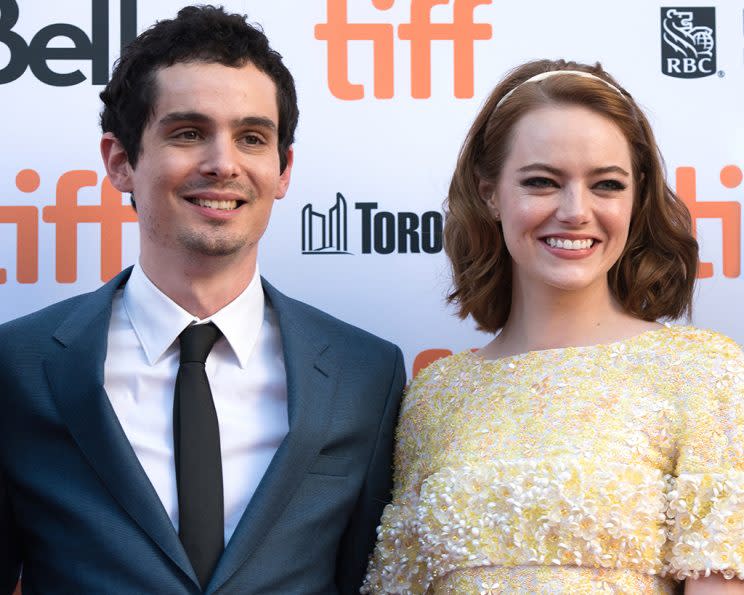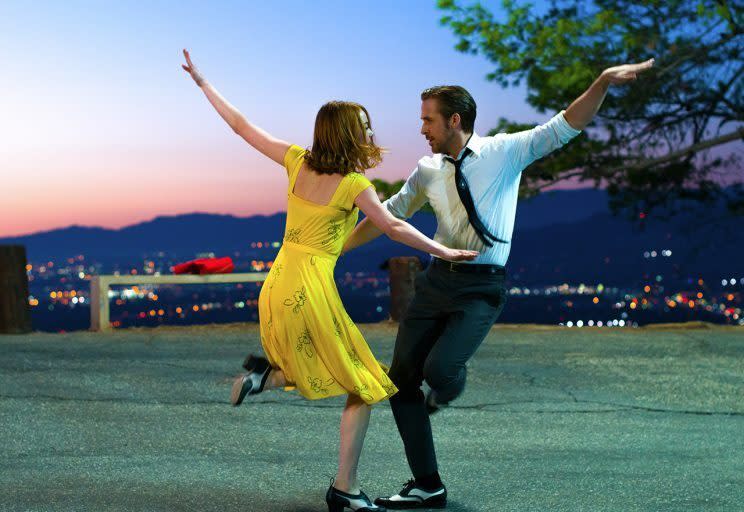Damien Chazelle Talks 'La La Land' and Making Classic Movie Musical Styles Sing Again

Damien Chazelle is having a moment. Again. Just two years ago, the filmmaker took the movie world by storm with Whiplash, an invigorating, whip-smart indie feature that pitted Miles Teller’s talented jazz drummer against J.K. Simmons’s fearsome music teacher. After becoming the toast of the festival circuit, the film received five Oscar nominations — including Best Picture — and won three. Chazelle took the caché he earned from Whiplash and has applied it to an unlikely dream project: an old-fashioned movie musical in the style of Gene Kelly (An American in Paris, Singin’ In the Rain) and Jacques Demy (The Umbrellas of Cherbourg, The Young Girls of Rochefort).
The result is La La Land, and it’s once again placed Chazelle in the position of having the fall’s most raved-about movie. Following its triumphant world premiere at the Venice Film Festival, this story of two young L.A. lovers, Sebastian (Ryan Gosling) and Mia (Emma Stone), went on to dazzle audiences at the Toronto International Film Festival this past week. Yahoo Movies spoke with the 31-year-old filmmaker two days after the movie’s North American bow to discuss the art and science of filming the movie’s applause-generating dance sequences and whether La La Land is poised to become the next Hamilton.
There’s an interesting dichotomy at play in La La Land: the central characters prize artistic purity above all else, and yet the world around them is highly stylized and almost theatrical. How did you develop that idea?
A large part of it was knowing the ending that we were building up to, which is a full-fledged fantasia filmed mostly on soundstages. So throughout the course of the movie, we were discussing how we could plant the seeds for that. Even though we shot in a lot of real locations, they’ve all been heightened, sometimes with little things like lampposts in places where they wouldn’t belong. Or the costume designer would find ways to make the colors of costumes pop against normal backgrounds. We were always finding little or big ways to make what was real seem a little fake; take a real city and, not disguise it, just bring out that undercurrent of magic behind it.
Damien Chazelle’s ‘La La Land’: Watch a trailer:
The final sequence clearly takes its cue in part from the dream ballet that serves as the grand finale of An American in Paris.
In the ’50s, dream ballets miraculously became a normal thing for Hollywood; I look back and think it’s so incredible that for a decade, Hollywood studios thought it was okay to stop the story and do these ballets against painted backdrops! [Laughs] It’s so avant-garde and defiant — I love the gutsiness of those ballets. An American in Paris is the high water mark of that, but they’re also in Singin’ in the Rain, The Band Wagon, and A Star is Born. So we were borrowing a lot from those films, but also trying to gear it toward an emotion that felt new. Not quite happy, not quite sad, this in-between emotional state that seemed like an interesting springboard to a dream ballet.
Watch a clip of Gene Kelly in ‘An American in Paris’:
One of the great joys of the film is the attention you pay to movement and dance in a way that few contemporary movie musicals do.
I think people have unlearned or mislearned how to film dance since Bob Fosse mastered his way of linking cutting to dance. West Side Story did that, too. It does an incredible job of ensuring that cuts always complement or counterpoint the dancing.
Watch an excerpt from the dance at the gym in ‘West Side Story’:
Some of the later musicals wound up doing amazing things with that approach, but since then it’s kind of unraveled a little bit. I wanted to look earlier at some of the ideas that Gene Kelly had. He was a pioneer in finding ways of filming dance that are totally fluid; if there’s a cut, you don’t feel the cut because it’s musical. He was trying to make a movie like a musician, because all those great dancers were musicians at heart. I wanted to take that basic idea and try to modernize it — make it feel more three-dimensional and bring it into the here and now.
Watch Gene Kelly in a dance scene from Jacques Demy’s ‘The Young Girls of Rochefort’:
An early standout sequence is Sebastian and Mia’s first dance together, which unfolds in a single take on a road overlooking Los Angeles. What was the process of rehearsing and shooting that scene?
During the week, Ryan and Emma would rehearse in the studio, and then on weekends, they’d rehearse on location. And being on location was very different because the road was slanted and full of potholes. So if you stepped in the wrong place, not only would you be out of focus, but you’d also break your leg! When it came time to shoot it, we knew we wanted a certain color of the sky, so we had a half-hour window to film the entire number. It’s a six-minute shot, so it was an hour of shooting total over two nights, and we were able to squeeze four or five takes in each night. I think we may have used the second take from the second night in the finished film. It was fun because it felt like live theater, partly because it was a long take.

With choreography that involved, did the actors ever get frustrated when they stumbled or missed a cue?
I wasn’t interested in disguising flubs or moments of humanity. I embraced those. You feel the reality of it more, it makes it feel more human. It was really important to me that the movie not descend into being an empty technical show-off. Each dance had to be about something emotional. Like that first dance between them is about flirtation and the electricity between two people. The dance in the planetarium is about nervousness, so you want to see the nervous steps of two people who are slowly reaching for each other and realize at the same time that they’re in love. That’s the moment where you feel your heart pounding in your chest, and the dance has to reflect that. I was lucky to have two actors who could carry those emotions through the dance numbers, and that’s probably what an audience connects to more than the dance steps.
Related: Emma Stone on Reteaming With Ryan Gosling in ‘La La Land’ and Her New Appreciation of Los Angeles
Did you write any additional original songs beyond the six that are featured in the movie?
There are a ton. And for every song that’s in the movie there are 200 demos of that song. The very first song we wrote was the love theme that’s threaded throughout the movie. That was actually written before the script. As soon as I had a basic story, I gave it to Justin Hurwitz, my composer, and he spent a few months finding a melody that could be the theme, because I wasn’t going to make the movie unless we could find a theme that would justify the movie. Once he finally landed on it, we wrote the script.
In this post-Hamilton world, La La Land seems uniquely poised to become everyone’s next musical passion. Do you picture people singing along to the soundtrack in their car the same way they do with Hamilton?
That seems far-fetched. [Laughs] Like everyone else, I adore Hamilton. I remember seeing it onstage and feeling that intense connection between audience and material. Somehow, the most incredible thing about it is that people come out interested in Alexander Hamilton! My favorite number in the show is the one where they’re debating how to handle the national debt, and the audience is applauding. That musical is an inspiration in showing that nothing is out of bounds. Even a genre that feels as outdated as the movie musical can be revitalized and made exciting. It was the same impulse that drove me to make Whiplash. Can I make a scary thriller about jazz drumming? You can take anything and make it exciting. It just takes the guts to take on that challenge.

